In the vast digital expanse, the relentless race to craft compelling content that stands out and attracts the target audience is in full swing. Every brand, from ambitious startups to established corporations, understands the pivotal role content plays in achieving business objectives.
However, even the most sophisticated content strategy can have blind spots, areas where competitors might be edging ahead, or where potential customers’ needs remain unaddressed. This is where content gap analysis enters the frame.
Content gap analysis isn’t just about identifying what you’re missing; it’s about discovering opportunities, refining strategies, and ensuring that your content ecosystem is as robust and comprehensive as it can be. Understanding how to leverage this analytical powerhouse is essential.
Dive in as we journey through the nuances of content gap analysis and how it can transform your content game.
The Essence of Content Gap Analysis
A content gap, at its core, represents an area of unmet needs or opportunities in your content strategy. It could be a topic your audience is searching for, but you haven’t covered, or perhaps a type of content format that resonates with them, but you haven’t yet explored. Recognizing these gaps means understanding where your content might be falling short in addressing user needs or desires.
Why does this matter? Imagine a potential customer searching for information about a particular product feature that you offer, but unfortunately, you haven’t covered it extensively on your website. This oversight could lead the customer to a competitor who has addressed that particular query comprehensively. Thus, identifying and filling content gaps not only aids in audience retention but also helps in capturing potential leads.
The connection between content gap analysis and improved SEO
Search Engine Optimization (SEO) isn’t just about stuffing your content with keywords. It’s about providing value to your users. When you address content gaps, you naturally extend the breadth and depth of topics covered on your site. This expansive content base can increase your site’s authority in search engine algorithms.
Moreover, by addressing queries and topics that your competitors haven’t, you can start ranking for niche keywords, boosting your visibility on search engines. Essentially, a refined content strategy influenced by gap analysis can propel your brand to the coveted top spots on search results, increasing organic traffic and engagement.
Benefits of identifying and filling content gaps
- Audience Engagement: By addressing topics and formats your audience cares about, you increase the likelihood of them staying on your site longer and engaging more deeply.
- Higher Conversions: Relevant content tailored to user needs can drive more conversions, be it newsletter sign-ups, product purchases, or service inquiries.
- Boosted Authority and Trust: Comprehensive content that covers a wide array of topics positions your brand as an authority, increasing trust among your audience.
- Competitive Edge: By diving into areas your competitors have missed, you can gain a distinct edge in the market, becoming the go-to source for specific topics or queries.

Starting with a Baseline: Auditing Your Current Content
Before venturing into the unknown territories of content gaps, it’s crucial to first map out the terrain you’ve already covered. Understanding your current content landscape allows you to discern what’s working, what’s not, and where potential opportunities might lie.
Think of it as a journey. Before plotting new destinations on your map, you first need to know your starting point. A thorough content audit offers clarity, ensuring you’re not retracing old paths or missing shorter routes to your goals.
Tools and methods to audit and catalog your current content
Several tools can assist in this audit process:
- Google Analytics: A free tool that provides insights into which pieces of content on your site attract the most visitors, the average time spent on pages, and where users tend to drop off.
- Screaming Frog: A website crawler that can quickly provide an overview of all your content, including titles, meta descriptions, and URLs.
- SEMrush: While primarily an SEO tool, SEMrush also offers features that allow you to understand your content’s performance, including traffic estimates, keyword rankings, and backlink data.
Conducting a content audit might involve categorizing content based on topics, analyzing the depth of content for each topic, noting down content formats (blogs, infographics, videos), and assessing user engagement metrics for each piece of content.
Using analytics to identify high-performing content
Analytics tools can provide a wealth of data that indicates the performance of your content. Look for:
Traffic Metrics: Indicate the popularity of your content.
Bounce Rate: If high, this might suggest the content didn’t resonate or wasn’t what the user was looking for.
Conversion Rate: Demonstrates the efficacy of content in driving users to take desired actions.
Identifying Your Competitors
Understanding the landscape of your competition is not about mimicking their strategies, but rather discerning where they might be gaining an edge and where there are opportunities for you to carve out a unique space. A successful content strategy doesn’t operate in a vacuum; it is informed by both internal goals and external competitive pressures.
Think of it as a chess match. To win, you not only need to be mindful of your moves but anticipate your opponent’s strategy as well. By identifying what content your competitors are producing, their strengths and weaknesses, and the audience they are engaging with, you can pinpoint gaps in your own strategy and leverage opportunities they might have missed.
Tracking competitors’ content performance
Once you’ve identified your main competitors, it’s essential to keep tabs on their content performance. This will allow you to:
- Understand what topics resonate with your target audience.
- Track any new content formats or styles they might be experimenting with.
- Stay updated on their frequency of content publishing.
Tools like BuzzSumo allow you to input competitor domains and see which of their content pieces are garnering the most social shares. Moz’s Open Site Explorer can help track the backlinks to your competitors’ content, offering insights into their off-page SEO strategies and their content’s perceived authority.
Key Features of Content Gap Analysis Tools
Content gap analysis tools come packed with various features, each designed to provide granular insights into your content’s performance and potential opportunities. Typical features include:
- Keyword Gap Analysis: Identifying keywords that competitors rank for but you don’t.
- Content Type Analysis: Understanding if competitors are leveraging content formats that you aren’t.
- Backlink Gap Analysis: Revealing websites that link to multiple competitors but not to you.
- Topic Analysis: Offering insights into topics covered by competitors but missed in your content strategy.
Differentiating between tools for beginners, intermediate users, and experts
For Beginners: Tools like Ubersuggest or Answer The Public provide simple insights, ideal for those just starting their content analysis journey.
Intermediate Users: SEMrush and Ahrefs offer a broader range of features that cater to businesses with a more established online presence looking to refine their content strategies.
Experts: Tools like Sistrix or Searchmetrics provide in-depth data analytics and visualization, suitable for brands with a vast content landscape and more complex competitive challenges.
Top Content Gap Analysis Tools and Their Strengths
The digital market is flooded with tools designed to help businesses identify gaps in their content. Understanding the unique strengths of each can assist you in selecting the most suitable for your business needs.
#1. Ahrefs
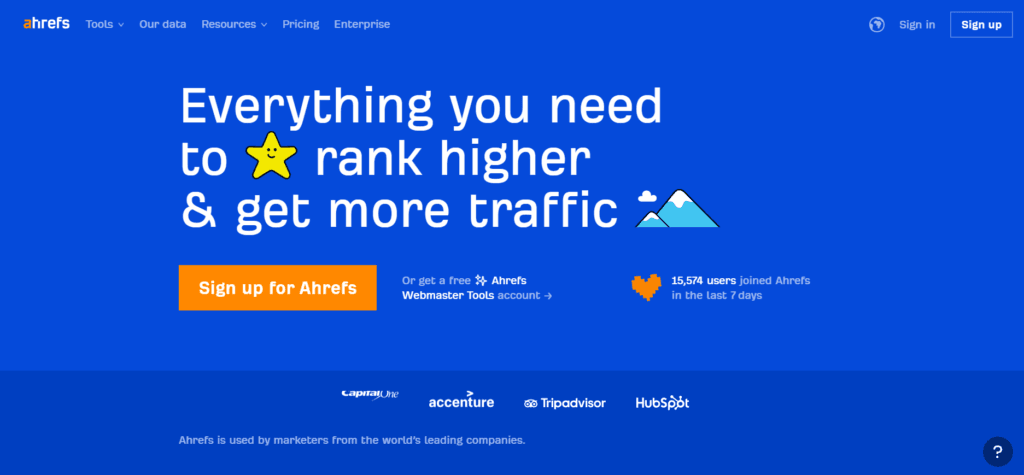
Features
Ahrefs is well-known for its extensive backlink database, but it also offers a robust content gap tool. With it, users can find the keywords their competitors rank for but they don’t. The tool provides valuable insights into the exact pages competitors have that are attracting organic search traffic.
Pricing
Ahrefs offers several pricing tiers starting from $99/month for their Lite plan to $999/month for the Agency plan. Discounts are available for annual subscriptions.
Pros
- Comprehensive backlink and keyword database.
- User-friendly interface with clear visuals.
- Provides actionable insights based on competitive analysis.
Cons
- Can be pricey for small businesses.
- May have a steep learning curve for beginners.
#2. SEMrush

Features
SEMrush is a versatile SEO tool that includes a content gap analysis feature. The tool allows users to compare their domain against multiple competitors simultaneously, revealing keywords for which any of the competitors are ranking in the top 100 search results.
Pricing
SEMrush’s pricing starts from $119.95/month for the Pro plan and goes up to $449.95/month for the Business plan.
Pros
- Provides data on organic, paid, and PLA (Product Listing Ads) keywords.
- Offers insights into competitors’ advertising strategies.
- Comprehensive keyword and domain analytics.
Cons
- Some features might be overwhelming for beginners.
- Costs can add up when accessing advanced features.
#3. Screaming Frog SEO Spider
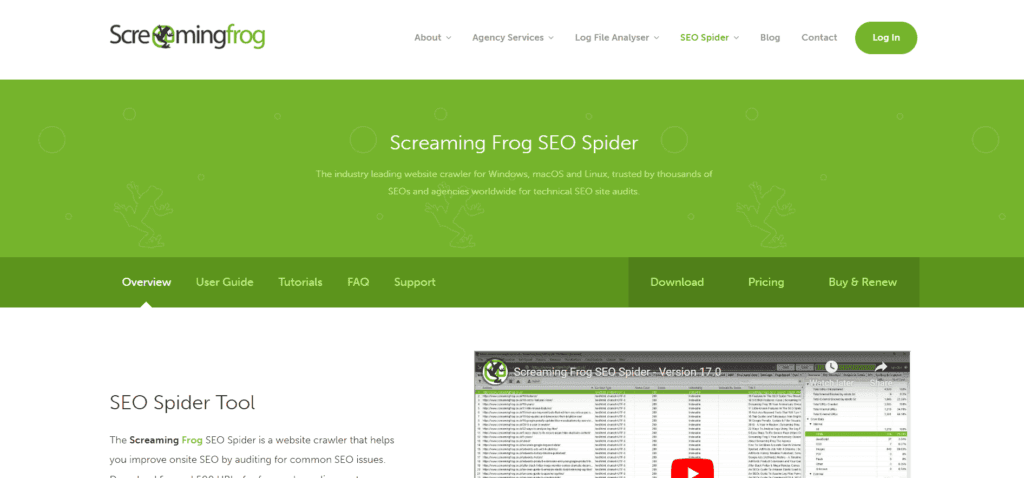
Features
While primarily an SEO crawling tool, Screaming Frog’s SEO Spider also allows users to fetch key onsite SEO elements of a site to identify content gaps. It does so by comparing crawl results of your website with that of competitors.
Pricing
There’s a free version available with limited functionalities. The paid version is priced at $149/year.
Pros
- Detailed insights into onsite SEO elements.
- One-time purchase with yearly updates.
- Allows for bulk exports of data.
Cons
- The interface might seem dated compared to other tools.
- Not as intuitive for those unfamiliar with SEO terminologies.
#4. BuzzSumo

Features
BuzzSumo focuses on content insights, allowing users to see what content performs best for any topic or competitor. It’s perfect for identifying popular content formats and topics within your niche, giving insights into potential content gaps.
Pricing
Pricing starts from $99/month for the Pro version to $499+/month for Enterprise needs.
Pros
- Ability to see top-performing content based on social shares.
- Provides influencer insights.
- Alerts for brand mentions and important keywords.
Cons
- Focuses primarily on content popularity rather than SEO metrics.
- Pricing can be on the higher side for some features.
#5. Moz Pro
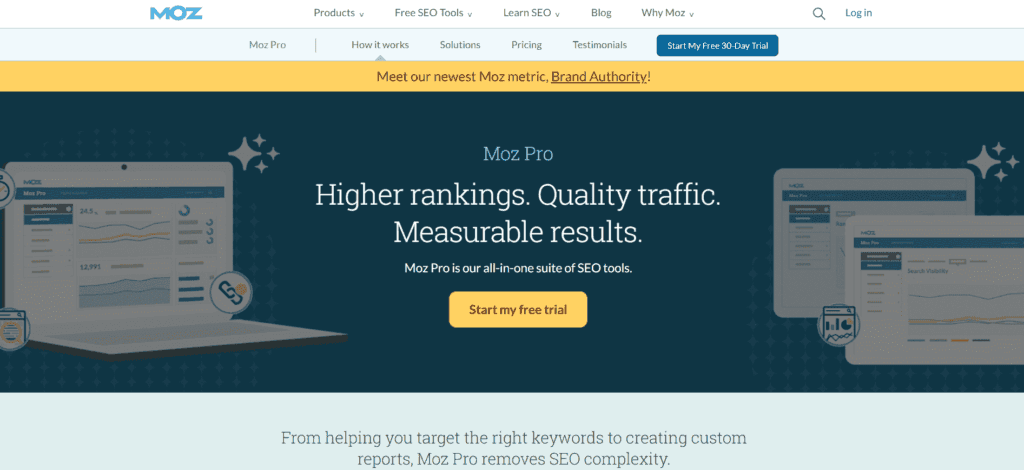
Features
Moz Pro is a comprehensive SEO suite that includes a keyword explorer tool. It helps users discover and prioritize the best keywords to target. By comparing your site with competitors, you can find opportunities to cover topics or keywords you might have missed.
Pricing
Moz Pro pricing starts from $99/month for the Standard plan and goes up to $599/month for the Premium plan.
Pros
- Extensive keyword suggestions.
- Provides a keyword difficulty score.
- Comes with a suite of other useful SEO tools.
Cons
- Can be expensive for smaller businesses.
- Some users find the tool less intuitive than competitors.
#6. Clearscope

Features
Clearscope specializes in content optimization. It analyzes top-performing content around a particular keyword and gives recommendations on terms to include, ensuring comprehensive coverage and identifying content gaps.
Pricing
Clearscope’s pricing starts from $350/month for the Essential plan.
Pros
- Great for content writers to optimize content in real-time.
- Easy to use with a focus on actionable recommendations.
- Integrates with popular CMS platforms.
Cons
- More suited for content optimization rather than a holistic content gap analysis.
- Pricing might be steep for individual bloggers or small businesses.
#7. Ubersuggest
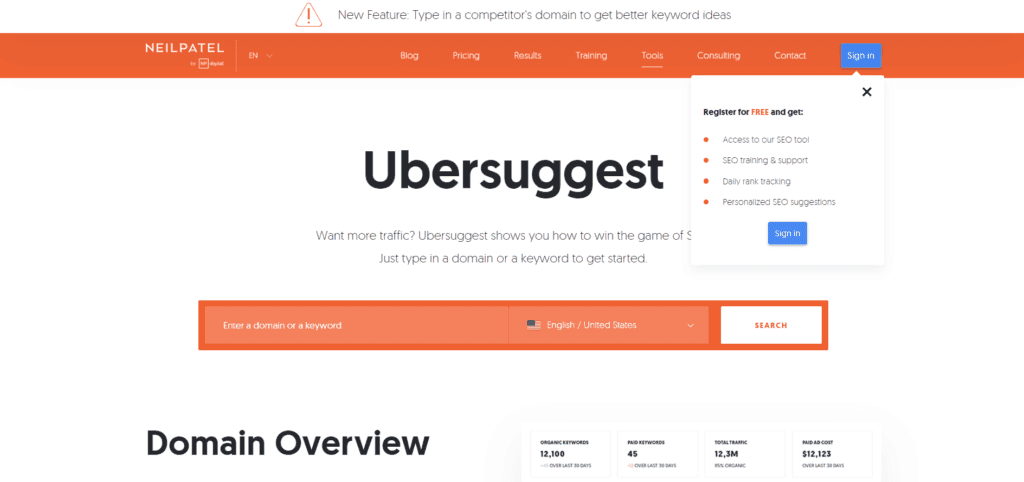
Features
Ubersuggest, created by Neil Patel, is a tool that allows users to get insight into strategies that are working for competitors. It provides keyword suggestions, backlink data, and an overview of content that’s performing well in organic search.
Pricing
They offer a free version with limited features. Premium plans range from $29/month to $99/month.
Pros
- Offers a broad range of SEO tools in one platform.
- User-friendly, especially for beginners.
- Competitively priced with generous features even in the free version.
Cons
- Depth of data might be lacking compared to more specialized tools.
- Some users report occasional inaccuracies in backlink data.
#8. SpyFu

Features
SpyFu’s main feature is its ability to let users download all the most profitable keywords for competitors. It’s especially known for its strengths in paid search (PPC) data but also offers valuable insights for organic content gap analysis.
Pricing
Pricing starts from $33/month to $299/month based on the features required.
Pros
- Strong insights into competitors’ paid and organic search performance.
- Allows for unlimited data downloads.
- User-friendly dashboard with a simple learning curve.
Cons
- Organic search data can sometimes feel secondary to paid search data.
- Some features might seem redundant for users only interested in content analysis.
#9. ContentGaps
Features
True to its name, ContentGaps focuses specifically on identifying gaps in your content strategy. It allows for a comparison of up to three competitors, showcasing keywords they rank for but you don’t.
Pricing
Starting at $29/month for the Basic plan, with higher tiers available based on user needs.
Pros
- Focused tool designed specifically for content gap analysis.
- User-friendly, especially for those new to the concept.
- Provides actionable recommendations.
Cons
- Lacks broader SEO functionalities found in more comprehensive tools.
- Might require integration with other tools for a full SEO strategy.
#10. MarketMuse

Features
MarketMuse uses AI to compare your content against competitors and provides recommendations for improvement. It’s not just about finding gaps but also about optimizing content to its fullest potential.
Pricing
Plans start at $79/month, but premium features may require custom pricing.
Pros
- AI-driven insights offer a unique perspective.
- Comprehensive content analysis beyond just gaps.
- Provides content optimization scores.
Cons
- Can be pricey, especially for advanced features.
- May have a learning curve for those unfamiliar with AI-driven tools.
#11. Keyword Revealer
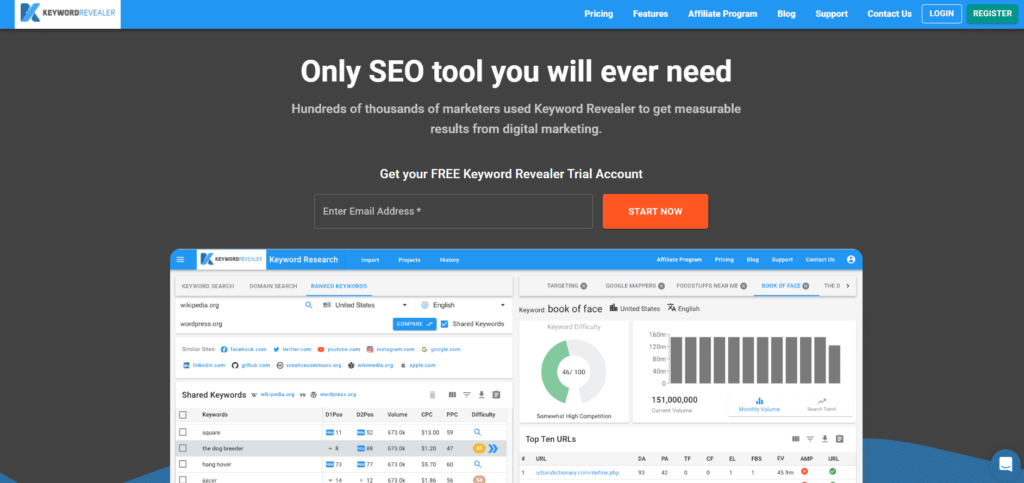
Features
Keyword Revealer is predominantly a keyword research tool, but its “Keyword Gap” feature allows for a direct comparison between your domain and competitors. This reveals missing keyword opportunities.
Pricing
Prices range from $7.50/month to $27.50/month, depending on features.
Pros
- Affordable tool with a straightforward interface.
- Offers a keyword brainstorming feature.
- Good for those with a tight budget.
Cons
- Less comprehensive than some competitors.
- Best when used in conjunction with other SEO tools.
#12. ContentKing
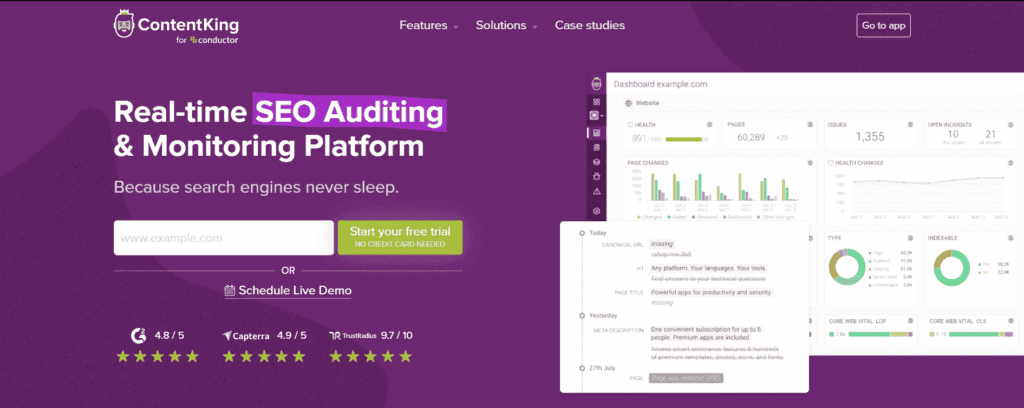
Features
ContentKing offers real-time SEO auditing and change management to improve and maintain website performance. While not strictly a content gap tool, its auditing features can reveal gaps in on-page content strategy.
Pricing
Pricing is based on the number of pages and starts at $19/month.
Pros
- Real-time SEO insights set it apart from many tools.
- Provides actionable recommendations.
- Focuses on preventing SEO issues as well as fixing them.
Cons
- Content gap analysis is indirect and might require interpretation.
- Pricing can get high for websites with numerous pages.
#13. Serpstat
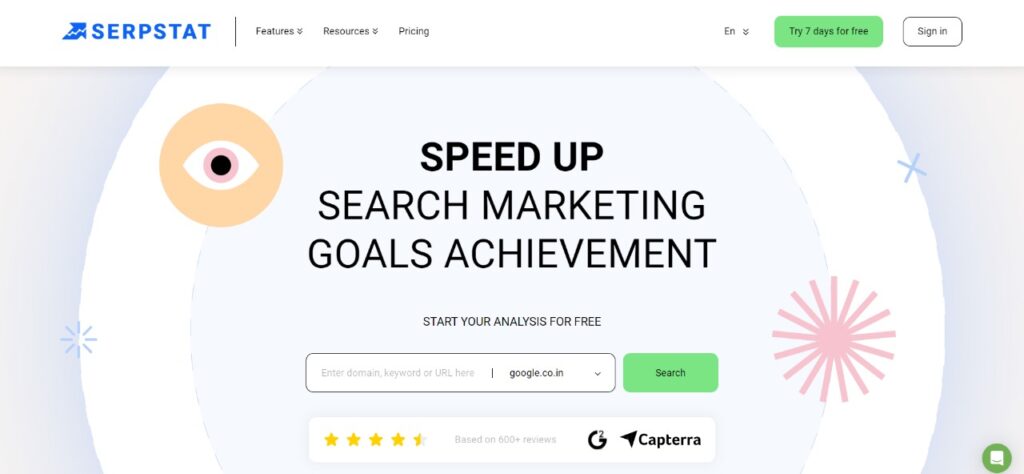
Features
Serpstat offers a suite of SEO tools, including keyword research, backlink analysis, and competitor research. Its content gap tool identifies missing keywords by comparing your domain with competitors.
Pricing
Plans start from $55/month for the Lite version, with higher tiers available.
Pros
- Comprehensive toolset for a competitive price.
- Provides an SEO audit feature to identify site issues.
- Easy to navigate and understand.
Cons
- While comprehensive, it may not delve as deep into specifics as some other tools.
- Might not have as frequently updated data as some competitors.
#14. CognitiveSEO

Features
CognitiveSEO offers a range of SEO tools, including content audit and competitor analysis. Its content tool evaluates your content compared to competitors, highlighting gaps and suggesting improvements.
Pricing
Plans start at $129.99/month.
Pros
- A comprehensive toolset for SEO and content analysis.
- Provides a visual content performance indicator.
- Useful backlink analysis in addition to content tools.
Cons
- The user interface might require a learning curve for beginners.
- Monthly pricing is on the higher side for small businesses.
#15. SurferSEO
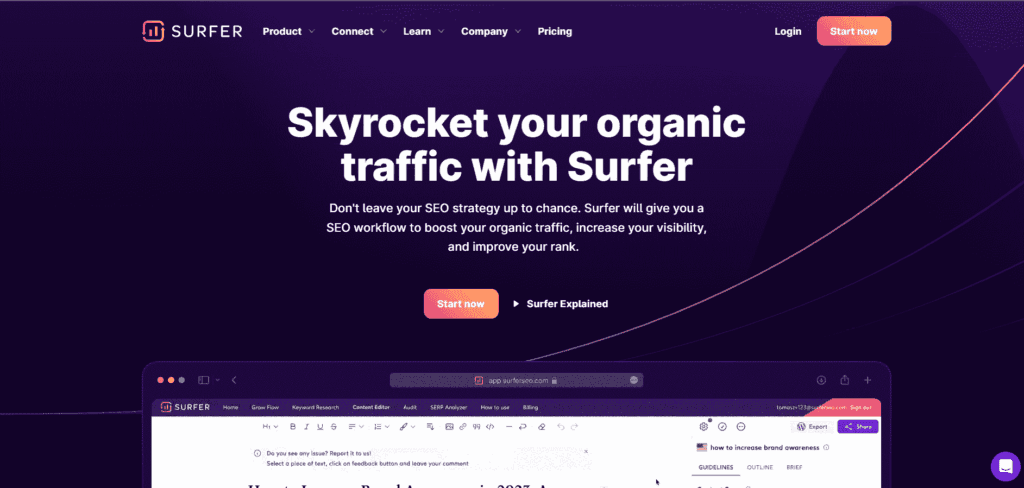
Features
SurferSEO provides content and on-page SEO analysis. By examining over 500 on-page factors, it helps users see how their content stacks up against competitors, revealing gaps and suggesting enhancements.
Pricing
Basic plan starts at $59/month, with more comprehensive plans available at higher price points.
Pros
- Offers a visual content editor for real-time optimization.
- Analyzes on-page elements in-depth.
- The audit feature is robust, offering insights on multiple SEO elements.
Cons
- Some features might be redundant for users with other SEO tools.
- Keyword analysis might be less comprehensive than dedicated keyword tools.
#16. Sistrix

Sistrix is a powerhouse, offering in-depth data insights for advanced users.
Features:
- Visibility index for domain performance
- Keyword data and rankings
- Link module for backlink analysis.
Pricing:
Starting at $200/month, with modules priced separately.
Pros:
- Provides deep insights with data visualization
- Used by many big brands for comprehensive analysis.
Cons:
- Expensive for small businesses
- Might be overkill for simple content gap needs.
Performing Content Gap Analysis: A Step-by-Step Guide
In the realm of content marketing, knowledge without action is merely trivia. It’s vital to transform insights from content gap tools into a practical action plan.
Step 1: Setting clear objectives for the analysis
Before diving into any tool, define what you aim to achieve. Are you looking to increase organic traffic? Or perhaps you’re targeting better user engagement or higher conversions. Your objectives will guide the data you focus on and how you interpret results.
Step 2: Inputting data and configuring tool settings
Most tools will require you to input your domain and select competitors. Ensure you’ve chosen competitors wisely based on relevance and not just industry giants. Adjust tool settings to suit your region, language, and specific industry for more accurate results.
Step 3: Analyzing results and extracting actionable insights
Once the tool populates data, sift through it to find patterns. Are there common keywords competitors rank for that you don’t? Are there content formats you haven’t yet leveraged? Prioritize insights based on their potential impact and relevance to your set objectives.
From Analysis to Action: Building a Content Plan
Having a deep well of insights is just the starting point. What differentiates successful content marketers from the rest is their ability to translate these insights into actionable strategies.
Interpreting the data from content gap tools
Once you’ve completed the analysis, you’ll likely be looking at a wealth of data. Start by categorizing this data. Which keywords are you not targeting but should be? Which content formats are underrepresented in your strategy? These patterns will begin to dictate the shape of your content plan.
Crafting a strategic content plan to address gaps
Your content plan shouldn’t merely be a reaction to the gaps identified. Instead, integrate these findings into your overarching content strategy.
For example, if your gap analysis points out that you’re missing out on video content related to certain keywords, don’t just randomly start producing videos. Ask yourself:
- What stories can we tell through video that we can’t through text?
- What’s the competition like for these keywords in video form?
- Can we produce high-quality video content, or do we need to outsource?
Addressing gaps is about merging the opportunity with your brand’s strengths and unique voice.
Prioritizing content creation based on potential impact
While it’s tempting to jump on every opportunity, prioritize. If a missing keyword has the potential to drive significant traffic, it might be worth pursuing before a less impactful one. Similarly, if a certain content format (like infographics or podcasts) resonates exceptionally well within your industry, prioritize that.
Bridging the Keyword Gap: SEO-Driven Content Strategies
Your website might have fantastic content, but if it isn’t optimized for the right keywords, it can become a lost island in the vast ocean of the internet.
At its core, SEO is about ensuring your content aligns with what people are searching for. If your competitors rank for keywords you don’t, you’re missing out on potential traffic.
Using content gap tools to uncover missed keyword opportunities
While tools like Ahrefs and SEMrush can help identify these gaps, it’s crucial to contextualize them. A keyword might have high search volume, but if it’s not relevant to your business or audience, chasing it can be counterproductive.
Crafting content around these keywords for maximum impact
Once you’ve identified high-value keywords, start crafting content around them. This doesn’t mean stuffing your articles with these keywords but creating valuable, relevant content that organically integrates them.
For instance, if you’re a digital marketing agency, and you find a keyword gap around “local SEO strategies,” you could create a comprehensive guide, a video tutorial, or even a case study showcasing your success in local SEO.
Addressing Gaps in Content Types and Formats
Modern content marketing isn’t just about blog posts. With audiences consuming content in various formats across platforms, diversification is key.
Different audiences have different content consumption habits. While one segment might prefer in-depth white papers, another might gravitate towards quick video tutorials. By diversifying content, you cater to a broader audience spectrum.
Using gap analysis to identify underutilized content formats in your niche
If all your competitors are heavily investing in podcasting, but you aren’t, it’s a missed opportunity. Content gap tools can shed light on format disparities, allowing you to venture into untapped territories.
Strategies for diversifying content formats based on user engagement data
Once you’ve identified these gaps, study your audience. Use tools like Google Analytics to see how they engage with various content types. If they spend more time on video content or frequently share infographics, it signals a preference.
Continuous Monitoring and Iteration
The digital landscape is not static; it’s dynamic and ever-evolving. What worked yesterday might not be effective tomorrow. As such, a one-and-done approach to content gap analysis won’t suffice.
The need for ongoing gap analysis
Even after conducting an exhaustive gap analysis and creating content to fill those gaps, the job isn’t finished. Competitors will adjust their strategies, new players might enter the market, and search engine algorithms will evolve. Regularly performing gap analysis ensures you remain proactive rather than reactive.
Tools and strategies for continuous content performance monitoring
Modern analytics tools, such as Google Analytics, Google Search Console, and various content gap tools, provide real-time insights into content performance. Setting up automated reports or monthly reviews can help you spot trends, anomalies, or emerging gaps in your strategy.
It’s also beneficial to maintain a content calendar. This not only helps in planning but also in evaluating which content pieces performed best, allowing for effective iterations.
Adjusting content strategies based on evolving industry trends and competitor movements
Staying ahead of the curve often involves anticipating changes in the industry and adjusting your content strategy accordingly. If a competitor suddenly starts gaining traction with a new content format or topic, it’s worth investigating and understanding their strategy.
Likewise, if there’s a sudden surge in search volume around a specific topic relevant to your industry – perhaps due to news events or emerging trends – it’s an opportunity to produce timely content that captures that interest.
Best Practices in Content Gap Analysis
To ensure that your content gap analysis yields actionable results, it’s imperative to adopt certain best practices and avoid common pitfalls.
Common pitfalls and how to avoid them
- Surface-level Analysis: Simply targeting high-volume keywords without understanding their relevance can be detrimental. Avoid this by always contextualizing keywords within your industry and audience needs.
- Ignoring the Competition: Just because a competitor is producing content on a topic doesn’t mean you should too. However, not monitoring competitors at all is equally dangerous. Strive for balance.
- Neglecting Content Formats: Not all content is textual. Ignoring video, infographics, podcasts, and other formats can mean missing out on engaging a segment of your audience.
Tips for maximizing the benefits of content gap tools
- Regular Reviews: Make content gap analysis a regular activity, not a one-off task.
- Combine Tools: No single tool can offer a 360-degree view. Use multiple tools to get a holistic understanding.
- Engage Your Team: Content gap analysis shouldn’t be the sole responsibility of the SEO or content team. Engage product teams, sales, and even customer support for a rounded perspective.
Integrating Content Gap Analysis with Other Marketing Strategies
Content is a cog in the vast machine of digital marketing. To maximize its effectiveness, it’s crucial to ensure that it integrates seamlessly with other marketing endeavors.
How gap analysis complements other digital marketing activities
For instance, insights from content gap analysis can inform PPC campaigns. If there’s a keyword you can’t rank organically for in the short term, perhaps due to stiff competition, you might decide to bid for it instead. Similarly, insights about popular content formats can guide your social media strategy.
Synchronizing content strategies with email marketing, social media, and PPC
Ensure that your content calendar aligns with email marketing schedules, PPC campaigns, and social media plans. If you’re launching a new product and have created content around it, coordinate its release with email newsletters, social media promotions, and targeted PPC ads for a cohesive and amplified effect.
The holistic approach: Ensuring all marketing channels benefit from gap insights
By ensuring that all marketing strategies are data-informed and aligned, businesses can create a harmonious and consistent brand experience for users. When each channel speaks the same language and amplifies the same message, it reinforces brand recall and strengthens customer relationships.
Wrapping it up
Content gap analysis is more than a mere competitive analysis tool; it’s a compass guiding your content strategy towards relevancy and impact. By understanding where your content stands and identifying where it could be, businesses can craft content that not only ranks but resonates. Leveraging the insights from these tools allows brands to be proactive, meet audience demands, and stay ahead in the digital race.
Continuous monitoring and integrating gap analysis findings with other marketing channels ensure a harmonious and potent digital presence. As the digital realm continues to evolve, staying attuned to these gaps and opportunities will be the cornerstone of successful content strategies.
Read Next:
- Smart Contracts vs. Traditional Contracts: Why do you care?
- How to Create Buyer Personas for Your Business in 6 Steps
- Email List Building Tools and Techniques: A Deep Dive
- How to Utilize Retargeting for Email Engagement
- Multilingual SEO: How to Target Multiple Geographies





















Comments are closed.